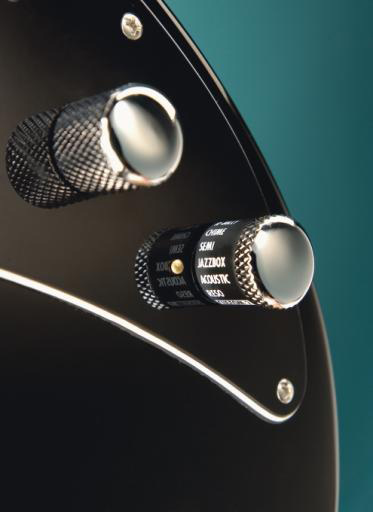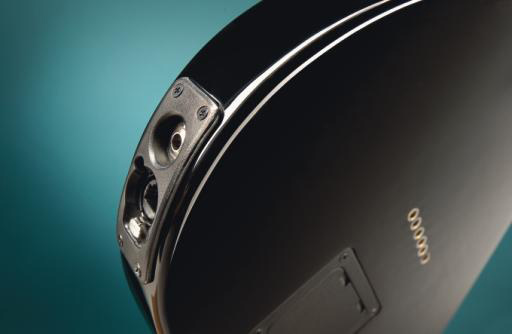MusicRadar Verdict
While this supremely versatile instrument is perhaps the ultimate studio guitar, it is also very flexible in a live environment.
Pros
- +
The Variax concept. The price. Upgraded sounds.
Cons
- -
The actual guitar is ordinary. XPS-Mini is not as flexible as the 500/700’s XPS. No nylon string acoustic model.
MusicRadar's got your back



After launching the 500 series guitar and higher-spec´d 700 series, Line 6 introduced Variax Acoustic and then the Variax Bass. Then followed the Variax 300, the most affordable version of this concept to date.
At nearly half the price of the 500, Variax 300 seems, outwardly at least, to be pretty much on par build-wise. Importantly, the modelling ‘engine´ is identical to that in both the 500 and 700. So how has Line 6 reduced the cost?
Firstly, Variax 300 is made in Indonesia, not Korea (the 500) or Japan (the 700), and we can assume there are fundamental cost-savings as a result. Secondly, the electronic guts of the guitar are loaded on to the scratchplate - the rear of the guitar simply hosts the battery compartment backplate, unlike in the 500 and 700 which have a large electronics coverplate and body-mounted electronics.
Instead of basswood the body is agathis - commonly used on Far Eastern electrics - and as a result the guitar weighs in at a near perfect 8lbs (3.6kg). The overall outline appears identical although, as you may expect, the forearm and rib contours differ slightly from the 500´s. As we´ve said before, Variax isn´t the sexiest design but it is highly functional. The guitar hangs well on a strap and feels fine played seated, while access to the top 22nd fret is easy thanks to those dual cutaways.
Shape
The neck is bolt-on maple with a rosewood ´board, held to the body with the same four recessed screws on the chamfered body heel as the 500. Although the 300´s nut width is slightly bigger than our reference 500 (12th fret dimensions are identical), the neck depths are pretty much the same and so is the overall shape - a quite bland but acceptable-feeling ‘C´. The necks do feel slightly different in the hand though; there´s a little more shoulder on the 300 in the lower fret positions, which makes the 500´s slightly more ‘V´-d lower fret profile feel skinnier. But, frankly, we´re splitting hairs.
Instead of Variax 500 and 700´s three-a-side headstock the 300 sports a six-in-a-line shape derived from the Variax bass. Unlike a Strat, however, there´s quite a step from the neck´s back to the back of the headstock.
A Fender´s neck has the neck back and headstock back in the same plane, but this stepped head is common on lower-end Far Eastern guitars (we're not sure why) although it does mean there´s a little more back angle over the white plastic nut to the tuners. Once again we have a clear matte finish to the neck´s maple. A slightly vintage tint would add a little sex appeal as the maple itself is very bland looking, and not helped by the dull brown of the Far Eastern rosewood.
Rough
While the set-up is reasonable (slightly high at the nut but far from unplayable) the frets ends are slightly protruding from the fingerboard edge, which immediately gives a sharp feel in the hand. The satin finish to the neck back is quite rough as well, and the fingerboard face also looks a little dry while the frets lack a good polish.
In all fairness, however, there are thousands of guitars in this condition on shop walls all around the world. It took no more than 15 minutes to slacken off the strings and tape them behind the neck, run a fine file along the fingerboard edges, round the ´board´s edges with a backed razor blade, polish the frets and fingerboard face with wire wool, add a little lemon oil and plenty of elbow grease, and lastly run some wire wool over the neck back. Sure, it didn´t turn Variax 300 into a Tom Anderson, but it dramatically improved the feel.
To accommodate the electronics the scratchplate has been enlarged and the control positions altered for more of a Strat-like layout. The five-way selector - which voices five sounds from any of the 12 model banks - sits above the volume and tone control, and the rotary model selector switch is the last control in the line.
As before, the output jack and the RJ-45 connector (protected with a rubber cap) are side-mounted. The LR Baggs X-bridge - which sends the string information to the digital gubbins via its piezo pickups - is non-vibrato and strings load, Tele-style, from the back of the guitar.
Sounds
Without any magnetic pickups, the sounds available are all digitally modelled representations of various solid, semi and hollowbody electrics, plus acoustics - including resonators - and we even get a Coral sitar and Gibson banjo thrown in. We suggest selecting a clean amp sound and, with the well-written manual in front of you, go through the 28 modelled instruments one by one. That way you´ll hear the differences in timbre and output.
Unlike with the 500 and 700, the supplied plastic enclosed XPS-Mini is simply a phantom power device for the guitar. The full-blown metal cased XPS also allows you to select the output destination of Variax so you can send your ‘magnetic´ pickup models to a regular guitar amp and, at the push of the footswitch, the acoustic models to an acoustic amp or PA. For live use, the XPS Mini is limited.
But this is probably the only deficiency in the 300 package - we still get a 10ft Planet Waves TRS cable, and the sounds available (which have apparently been subtly upgraded) are, for the most part, really good.
Everyone has their favourites: the Les Paul neck position is a wonderfully big and fat tone that´s impressive for slide and blues styles. The Strat sounds are still a little tight but the hum-free single-coil tones are no less accurate than you´d get splitting a humbucker.
Variax´s trump cards, however, are the two custom banks into which you can load five sounds apiece. Les Paul neck, middle and neck Strat, a Tele´s combined bridge and neck, a Gretsch 6120´s bridge pickup and, hey, let´s throw in a Les Paul Special bridge P-90.
You can assign the second custom bank to maybe some acoustics - cranked up through a club PA, Variax becomes a powerful non-feedback electro - with a choice of larger sounding dreadnoughts, a small parlour and choice of resonators. And if you want to use Variax primarily as an electro then just fit heavier gauge acoustic guitar strings - it´ll still work and sound more accurate. There´s an awful lot to get your head around, but set up Workbench and the possibilities multiply much further.
MusicRadar is the number 1 website for music makers of all kinds, be they guitarists, drummers, keyboard players, djs or producers...
GEAR: We help musicians find the best gear with top-ranking gear round-ups and high- quality, authoritative reviews by a wide team of highly experienced experts.
TIPS: We also provide tuition, from bite-sized tips to advanced work-outs and guidance from recognised musicians and stars.
STARS: We talk to musicians and stars about their creative processes, and the nuts and bolts of their gear and technique. We give fans an insight into the actual craft of music making that no other music website can.
Baby Audio's Smooth Operator spectral balancing plugin goes pro
"It was ugly, like watching a divorce between four people. After a while, I had to get out": Beatles engineer Geoff Emerick on the recording of Abbey Road, track-by-track
"I said, “What’s that?” and they said, “It’s what Quincy Jones and Bruce Swedien use on all the Michael Jackson records": Steve Levine reminisces on 50 years in the industry and where it’s heading next










